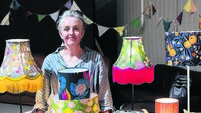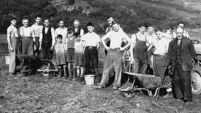Celebrate the Irish... by using these 10 phrases as Gaeilge

The Irish - and our animals - love to celebrate St Patrick’s Day, but as well as the fun vibe this year, how about learning some Irish phrases to drop into everyday conversation, suggests Kathriona Devereux.
They stand in stark contrast to the locals ag siúl go tapaidh to get out of the gaoth fuar na Márta.
Na Meiricéanaigh have landed - March, the month of celebrating Irishness, is underway.
In the twists of history, somehow celebrating Irishness has evolved into an extravaganza of parades, revelry, and wearing outlandish green white and gold plastic tat. Not what the 5th century Patrick would have been into, I suspect.
How about instead of displaying our love of being Irish by wearing glittery shamrock-shaped sunglasses, we display our Irish identity by speaking Irish and sprinkling Gaeilge into our everyday conversations and interactions?
We can all get on board the wave of positivity created by films like An Cailín Ciúin and Kneecap towards our national language. Both films challenged the outdated perception of Irish as a dying or old-fashioned language.
An Cailín Ciúin highlighted the poetic and emotional beauty of the language, and Kneecap reclaimed it as a rebellious urban language that represents identity and resistance, especially in Northern Ireland.
Much of what stops us from speaking Irish is our fear of getting it wrong. But we need to cast aside the notion that if we’re not líofa (fluent), then we shouldn’t use it.
When we go on ár laethanta saoire go dtí Spáinn, we are happy to trot out our modest Spanish phrases - “una cerveza por favor” “Donde es el supermercado” “Muchos gracias” - why not take the same approach to Gaeilge?
The proverb “Is fearr Gaeilge bhriste ná Béarla cliste/Broken Irish is better than clever English” is a snappy summation, but I think we should be putting the slogan “Is fearr Gaeilge bhriste ná gan Ghaeilge ar bith.” (Broken Irish is better than no Irish at all) on t-shirts.
These are easy phrases that we can use every month of the year, not just in March, which are a meaningful way of normalising the use of Irish, and celebrating our Irish identity beyond Aran jumpers and St Patrick’s Day shenanigans.
At the end of work Zoom calls, bidding my páistí farewell, hanging up phone calls - I’ve replaced “bye” with “slán” on all occasions. It’s an easy swap. Everyone understands it.
It’s like saying “Ciao” - except in our mother tongue. It would be great if everyone just started saying Slán as a national habit.
It’s as easy to replace a “thank you” with a “go raibh maith agat” in your daily interactions. Try it. You’ll be surprised how many shopkeepers will happily respond with a “tá fáilte romhat”.
Even non-Irish retail workers, usually multi-linguists themselves, know what “go raibh maith agat” means and are happy to hear it.
Adding email sign-offs as Gaeilge is a simple way to insert Irish into daily communications. I like to use “Le meas” as a replacement for “Kind regards”, or a more informal “Míle buíochas” for people who are helping me out at work.
Or just sign off “GRMA”(go raibh maith agat), which is also handy shorthand in messages.
Irish people love to know how you are getting on and there are so many nice ways of asking in Irish. “Aon scéal?” (What’s the story?). “Conas atá cursaí?” (How are things?). “Conas atá tú?” (How are you?).
An easy response to “conas atá tú” is to bat the question back with a “Go maith, agus tú féin?” (Good, and you?)
I love an instruction as Gaeilge. They take the edge of what could be considered a snappy order in English. We use Amach! (Out!) regularly in our house to get the kids to school and “Suas an staighre” (Up the stairs) agus “Isteach sa leaba” (Into bed) is uttered every night.
Other regularly used favourites include “Brostaigh!” (Hurry!)”, Ar agaidh linn!” (Let’s go!), Dún an doras (Shut the door!).
Just as useful as the phrase “ok”. Pretty much everyone understands what “ceart go leor” means and it can be deployed in so many situations.
7. Mol an óige agus tiocfaidh síad
Praise the youth and they will flourish. Praise them in Irish and they will flourish even more!
For me, giving praise and congratulations to anyone, not just kids, is elevated by by saying it in Irish. Maith thú (Well done), Comhgairdeas (Congratulations).
When you start throwing a smattering of Irish into your everyday life, you’ll be surprised how many people respond positively and want to continue the conversation as Gaeilge.
Instead of shutting down, saying “Oh, I can’t actually speak Irish properly” start reminding yourself of a few handy phrases and core vocabulary that are lodged somewhere in the back of your brain that keep the conversation going. “An bhfuil tú/Are you” is a very useful one. An bhfuil tú sásta (happy), brónach (sad), réidh (ready).
Once you’ve started using your Irish regularly, you’ll find yourself wanting to use it more and more.
“Ba mhaith liom” (I would like) can be used to get you everything from a cupán tae to a teach nua!
I recently tried to order a coffee and babyccino as gaeilge in Café Myo, a fine establishment very supportive of speaking Irish. “Ba mhaith liom Americano amháin agus dhá… mmm... níl fhios agam.”
It’s inevitable to get stuck, but that’s when you deploy “Conas a deirfear” (how do you say) babyccinno?” No-one knew, so the barista agreed we’d call it a leanbh-ccino from now on.
So, this Lá Fhéile Pádraig, instead of just wearing green, why not wear your cúpla focal with pride and then keep it up the rest of the year!
Go n-éirí leat!







 App?
App?







